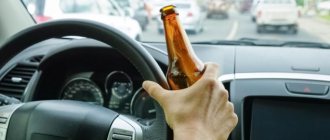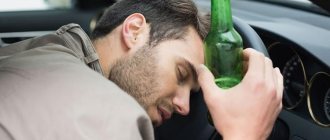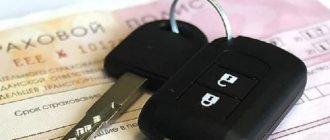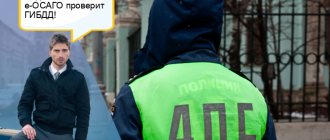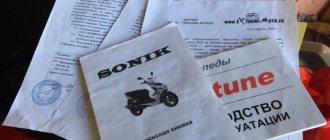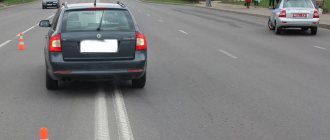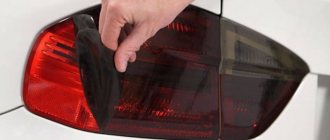Home>Articles> Non-alcoholic beer while driving: can you drink it?
quick menu (hide)
- Non-alcoholic beer, how soon can you start driving?
- Non-alcoholic beer while driving - is it possible or not?
- Official studies
- Conclusions of the research results
- additional information
- How to protect yourself
Various drinks are sold today in a huge assortment - even non-alcoholic wine and beer are displayed on store shelves. But is it possible to drink non-alcoholic beer while driving? What are the consequences of using a seemingly harmless thirst quencher? Is it recommended for motorists? Such nuances worry many motorists. How much foam can you drink? Do you get behind the wheel right away? Opinions on this differ, but it makes sense to consider the issue in maximum detail, detail, and nuance.
Manufacturing companies indicate that there is no alcohol at all. Based on the statement promoted by the manufacturers, many people believe that drinking “zero” before a trip is acceptable in any quantity; there will be no ppm when tested. It is worth disappointing people with similar beliefs: there is alcohol in it , although in a small amount. Curious car owners have conducted a number of experiments , the results of which are worth finding out before buying or drinking non-alcoholic beer while driving.
Non-alcoholic beer, how long before you can start driving – practical tests
After trying the non-alcoholic foamy drink, people note that the aroma matches the usual solution with traditional ethyl content. But will it be possible to get drunk and experience a state of intoxication when using it? It is important to check the possibility, since it is alcohol intoxication that causes accidents and incidents on the roads; because of it, the use of alcohol by motorists is prohibited by law.
In one of the experiments, a person undertook to prove that the version deprived of strength cannot cause this condition. After drinking 10-11 liters, he felt a sharp deterioration in his health. However, the condition was not caused by alcohol, but by excess fluid in the body. As for the medical view on the question, there is no clear opinion on whether it is realistic to get drunk from it . Opinions vary, disputes continue today, each side has evidence.
Is it possible to drink non-alcoholic beer while driving?
Ethyl alcohol is contained in every foam , despite manufacturers' statements to the contrary. Everyone should know this fact. There are many products that contain alcohol for daily consumption, despite the fact that they are not classified as alcohol. Tan, kefir, kvass, ayran belong to this category; a small amount of ethanol appears in them during the production process, naturally , subject to compliance with production technology. Both when consuming them and when tasting non-alcoholic foam or wine, the breathalyzer shows a certain result. 0.02 ppm in the blood is a typical reading a few minutes after drinking. Is it possible to drive after drinking non-alcoholic beer? The answer to this question is debatable - after checking, taking indicators in a particular case. Manufacturers have their own technologies, and the human body also has its own characteristics. One brand may not provide high performance, while another will. Every year new brands of drinks appear; it is not possible a single statistics It is necessary to take into account the characteristics of the body, the number of hours, minutes between drinking alcohol and getting behind the wheel. 0.35 ppm is a critical parameter for Russian legislation in 2021; it can be achieved completely unnoticeably.
Can kvass test positive for alcohol?
Kvass is a fermentation product. It contains a small amount of alcohol. That is why some drivers are concerned about the question of whether it is possible to drive after drinking kvass.
The drink causes fermentation in the digestive tract.
Kvass is one of the products that should not be consumed while traveling. The drink can give a positive result on a breathalyzer if the driver encounters a state traffic inspector. It should also be taken into account that kvass comes in two types:
- barrel;
- bottle.
The first one is prepared according to the classic recipe. It is based on yeast, sourdough and dry bread. This kvass is bottled from barrels with the onset of summer. The bottle version is produced in automated production. It contains various sweeteners and flavors.
Barrel kvass
The barrel variety of the product is obtained through fermentation with wort. That's why the drink contains alcohol. Those who are interested in how much barrel kvass you can drink while driving should keep in mind that it is impossible to predict the concentration of ethanol in the blood after consuming the product.
Indicators are related to the characteristics of the organism. What number of ppm the breathalyzer will record depends on the type of device. The cooking technology also influences the indicators.
After drinking the drink, a breathalyzer may show 0.35 ppm. These indicators exceed the permissible norm. Here's another reason why you shouldn't drink kvass while driving. However, sometimes 10 minutes is enough for the amount of ethanol in the exhaled air to be zero.
Bottled kvass
Sometimes natural kvass is sold in bottles. It is manufactured according to GOST. However, most often manufacturers offer leavened drinks in this form.
They are unnatural. Bottled kvass contains sweeteners and flavorings. Carbonated water and dyes are also used to prepare the product.
If there is no yeast or barley wort in bottled kvass, the alcohol content in the former is zero. This drink can be safely consumed on the road. After taking it, the tester will not detect ethanol in the blood.
Official research - is it possible to drive after drinking non-alcoholic beer?
To find the answer, you can drive after drinking non-alcoholic beer, a drug treatment center engaged in treatment and research has taken over. controversial products - kumys, juice, two brands of soft drinks. The selection of material was objectively motivated by the fact that the listed drinks have a certain level of fermentation . As part of the experiment, eating other food before and during the experiment was not allowed. Among the people who were selected, there were men of different builds, with different indicators of immunity and other parameters. The results of the experiment were certified by specialists ; the test took place in the center.
Before the event, participants were examined, the final result was 0 ppm. Testing before and after the event took place using the same equipment. The information is very revealing and perfectly illustrates when you can drink non-alcoholic beer while driving.
- Apple juice did not leave any traces of alcohol either immediately or after 10-15 minutes;
- 0.5 liters of kumiss provided 1.04 ppm, negative marker after 10 minutes;
- 700 ml of kvass – a negative indicator immediately and then;
- 1 l. Baltika 0 - 0.1 percent immediately and negative - after 10-15 minutes;
- Clausthaler 1 liter – 0.1 percent after administration and 0 – after 10-15 minutes.
The test was carried out using equipment, with a survey after 15 minutes. The results of the survey also showed the absolute sobriety of the subjects. Summarizing the experiment examining non-alcoholic beer, how long it takes to drive a car, experts noted that in the experiment, after minutes, the traces disappear. Increased heart rate, speech disturbances, behavioral abnormalities, and a specific odor that raises questions were noted.
Conclusions according to the research results - how much non-alcoholic beer can you drink while driving?
Keeping this in mind, the motorist can feel safe, deciding that he has the opportunity to drink a bottle, wait 15 minutes and drive. This is a false belief; it is necessary to take into account a number of external factors and circumstances. A number of products can raise indicators - the driver sometimes forgets that he also consumed other fermentation products or medications, and “zero” beer will raise the already existing indicator to critical. Different breathalyzers can react slightly differently, sometimes producing slightly higher ppm, which is enough to cause a person problems on the road.
Each person has his own individual characteristics of the body - it is impossible to predict the reaction to alcohol, even in small doses. Fatigue and other factors play a role - a bottle of soft drink also causes a drop in concentration, which creates a dangerous situation. Fatigue and other individual reactions aggravate the problem. Inspectors with their professionalism also do not stand aside. Having smelled a characteristic odor , they initiate a check; a minimal or zero tester indicator will cause distrust, and they will have to go for a medical examination, wasting time and wasting their nerves. Such phenomena are absolutely useless.
Is it possible to drink non-alcoholic beer while driving - additional information
Euphoria and intoxication from low-alcohol drinks, as well as fermented milk drinks and a number of others, are quite possible . The effect is caused by kumis, whey. There is a list of products that can give euphoria and enhance the “effectiveness” of the intake. They initiate the fermentation , which results in the release of ethanol . Bananas provoke fermentation - especially overripe ones with spots on the peel. Eating bananas and drinking a bottle can cause significant problems with the traffic police. Kefir and yogurt are healthy, fermented milk is recommended for all people. The products contain lactobacilli, which improve digestion, as well as ethyl alcohol produced during the fermentation process. Natural chocolate contains a little ethylene - especially when used in cognac and other alcoholic beverages.
There is a certain amount of ethanol in citrus and fermented kvass . Even jam can contain small amounts of alcohol. The substance is found in dental rinses , medications, and flavored cigarettes. Not all products have the appropriate indication, and as for homemade ones, they are the most insidious. There are hundreds of recipes for making kvass; ppm values after consuming different types of kvass can vary very widely. A person may forget that he drank kvass in the morning or ate bananas, drink a bottle and get behind the wheel - problems with the traffic police in the event of a stop by an inspector will be almost guaranteed .
Medicines are also insidious . Many motorists know that it is necessary to carry the drug with them, and preferably a prescription or doctor’s prescription, in order to show them to inspectors in case of questions about alcohol. If, in addition to ppm, there is an odor, the demonstration of documents from the doctor and medications will be unconvincing, and you will have to deal with all the associated with the violation.
Is it possible to drink kvass while driving?
Various changes are periodically made to traffic rules.
The changes also affected the alcohol standards that may be present in the driver’s blood. Many drivers are interested in the question of whether it is allowed to drink kvass while driving, and whether one of the possible consequences will be the deprivation of driving documents.
Products containing alcohol. There are a considerable number of products on sale that, at first glance, seem completely safe, and it is quite difficult to imagine that they may contain alcohol. Despite the fact that the % of its content is quite low, the reaction still exists. These products include:
- Kvass;
- Fruit juice;
- Cigarettes;
- Bread made from rye flour;
- Refreshing oral spray;
- Chocolate candies filled with cognac;
- Various types of baked goods with poppy seeds;
- Nonalcoholic beer;
- All types of fermented milk products.
Alcohol content in products. The highest amount of alcohol content will be indicated by a special alcohol determination device immediately after the product containing alcohol has been taken. For example, after drinking barrel kvass, the alcohol level in the blood will be 5%. But after five minutes, its level will decrease significantly, and will already be 0.4 ppm, and after 15 minutes it will drop to zero.
Kefir contains a negligible amount of alcohol, so when checking on the device, it may not detect it. But the device readings will be 0.1-0.4 ppm after consuming products containing menthol, 0.4 - 0.5% when consuming slightly fermented juice.
Updated blood alcohol limits. In the period from 2010 to 2013, there was no ppm threshold, and the slightest detection of alcohol in the blood could lead to the deprivation of a driver’s license. In the summer of 2013, this threshold was reintroduced, and its acceptable value became 0.16 ppm, which is the current value to this day. But every driver should know that if alcohol appears in the blood as a result of consuming the products listed above, then it will disappear quite quickly. If you have consumed wine or alcoholic beer, then it is best to avoid getting behind the wheel, since the amended laws are very strict in this matter, and the deprivation of a driver’s license will not be postponed. For driving while intoxicated, the driver can be deprived of his license for a period of one and a half to two years, and for a repeated violation - for another three years. Refusal to undergo a medical examination will also result in loss of rights for three years.
Possibility of drinking kvass while driving. Kvass can be divided into three varieties:
- Store-bought, sold in aluminum cans or plastic bottles;
- Barrel, sold on tap;
- Home.
The strength of homemade kvass may vary, depending on the recipe and the amount of alcohol. Its content in a drink with a large amount of sugar and yeast can reach up to 7-8%, which is more than 5 times higher than the norm in the standard version. High-strength homemade kvass is contraindicated for use by drivers before driving, especially in large quantities. In addition, the amount of alcohol in the blood will be inversely proportional to body weight.
Bottom line. Despite the rapid elimination of alcohol from the body after consuming “safe” products, the most reliable way is to completely abstain from consuming alcohol-containing products before the trip. This will make it possible to avoid punishment and save your driver's license, and possibly your life.
Is it possible to drive after drinking non-alcoholic beer - how to protect yourself
Thus, even a drink with zero alcohol content is not the best choice for a car enthusiast; you should not drink it immediately before getting behind the wheel. Ethanol is actually present , albeit in small quantities. It gives an ultra-light degree of intoxication and creates a smell that attracts the attention of traffic police officers. Barring problems with the patrol service, you should refuse the possibility of drinking such beer. If it is accepted, it makes sense to chew coffee beans or high-quality tea to hide the smell, or chew roasted seeds . Chewing gum helps - in addition to mint, mouth rinses. It makes more sense to simply refuse the bottle, or put it off until after the trip, so as not to risk it. The decision will be the most correct - for some people even a psychological reaction , increasing the feeling of euphoria, but the driver cannot relax. Driving a vehicle is a responsible task.
Behind the wheel after the holidays: how motorists can avoid being left without a license
Useful mathematics
First of all, each of us should have at least an approximate idea of how long it takes for a certain type of alcohol to be eliminated from the body. Let's start with the fact that alcohol is eliminated from the male body much faster than from the female body. The rate of alcohol elimination in the fairer sex is 0.08 - 0.1 ppm per hour, in men - 0.1 - 0.15 ppm per hour.
The second important aspect is that the speed of sobering up directly depends on body weight. Let's take an average “celebrator” weighing 70 kg, raising 2 glasses of champagne. In this case, 200 ml of champagne will be excreted from the body within three hours. From 100 ml of vodka, the body of our 70-kilogram hero will cleanse itself much longer - 5 hours 30 minutes, from 100 ml of cognac - even longer: 6 hours. A person weighing 60 kg should add at least another half hour to this time, and someone weighing 90 kg, on the contrary, will sober up an hour and a half faster.
Individual indicators should also be taken into account, such as the characteristics of the digestive system. In any case, experts say, at least a day must pass after drinking alcohol before you can get behind the wheel. And to be completely sure that you get behind the wheel without breaking the law, you should check with a breathalyzer, which is best purchased at a pharmacy that sells high-quality and certified products.
Get ready for the holiday
If you intend to minimize the consequences of drinking alcohol, it is advisable to eat heavily before the celebration. Fatty foods, such as fried meats, are best because they will slow down the absorption of ethanol. Widely advertised antacids will have the same effect: Maalox, Rennie, Almagel.
Ten tablets of activated charcoal shortly before drinking alcohol will prevent rapid or excessive intoxication.
The main thing is to remember that you should not drink alcoholic beverages on an empty stomach.
If possible, do not continue the “libation” until late at night. Otherwise, your health in the morning will definitely not make you happy.
How to quickly come to your senses using folk remedies
Folk experience tells us that liquids and natural remedies with a diuretic effect will help speed up the removal of alcohol from the body: melon, strawberries, watermelon, herbs and herbs (chamomile, rose hips, thyme, calendula, linden, St. John's wort, flax seeds, sage, oregano ). Decoctions of diuretic herbs are best taken 50-100 ml every hour.
Mineral water and citrus juices, juicy fruits and, above all, lemon are also good for these purposes. Honey is also known to have diuretic properties. Here is one useful recipe - dissolve a tablespoon of honey in 200 ml of warm water. Drink this drink three to five times a day. A combination of green tea and ginger will also help you sober up.
If intoxication is accompanied by poisoning, milk is suitable to overcome the consequences. You should drink at least 200 ml of milk every hour, and within three hours the hangover symptoms will noticeably decrease. It is not recommended to drink strong tea and coffee to remove alcohol - these drinks only stimulate the nervous system.
To quickly replenish the body’s water-salt balance, you can also prepare hot broth.
Physical education and water procedures
To quickly recover from the holidays with strong drinks, water procedures will be very useful. A warm shower will help cleanse your skin and open your pores to remove any remaining alcohol. A bathhouse, hammam or sauna will give an even better effect. Jogging, skiing, swimming or working out in the gym will also have a similar life-giving effect. These recovery measures improve ventilation of the lungs, and the alcohol passes out faster.
However, we especially emphasize: such activities must be carried out with caution, since high air temperatures create additional stress on the heart. If you are not ready to subject your body to increased stress, walking in the fresh air is suitable. In any case, to sober up as quickly as possible, you need to move more.
Acupressure
An effective method in the fight against a hangover is to massage the ears along with the tip of the nose. The movements must be performed confidently and intensively, duration - at least five minutes.
You can also ease a hangover by massaging both index fingers for as long as possible.
Biologically active points on the feet also help reduce alcohol intoxication. Experts advise walking barefoot on a hard, bumpy surface the morning after a party.
A head and neck massage will also help improve cerebral circulation, reduce headaches, and speed up recovery. But these manipulations are best left to professional massage therapists.
Medications
If you celebrated too actively the day before, to speed up metabolism and remove toxins, it would be useful to take sorbents - Enterosgel, activated carbon, Polysorb, Sorbex. For the best effect, these drugs should be taken soon after the holiday with strong alcohol, preferably before bed. An important note: do not take other hangover medications together with sorbents, as the former will lose their effect.
Further, aspirin is known to relieve headaches. To prevent the medicine from damaging the gastric mucosa, it should be taken after meals. No-spa, which has an antispasmodic effect, will eliminate vasospasm. Vitamin B6 and ascorbic acid will help the body recover.
Alka-Seltzer (consists of aspirin, baking soda and citric acid), Medichronal, Zorex and the like also do their job well. These medications can be taken either before bed or in the morning.
There is another very effective way that allows you to quickly return to normal. You need to add one to three drops of ammonia to 100 ml of water. The ammonia contained in ammonia can revive a person who is intoxicated in a few seconds.
Good morning
Finally - seemingly banal, but very useful advice - the morning after the holidays, eat a hearty meal, and give preference to oatmeal porridge.
To quickly remove toxic substances from the body and help internal organs return to normal, you should also eat tomatoes for breakfast (they contain unique microelements that help the liver process harmful toxins faster), eggs (replenish proteins destroyed by alcohol), fruits and, above all, bananas and berries (they are rich in potassium, magnesium and iron, which are the first to be destroyed by alcohol) and grains, preferably with bran (they will give energy and strength).

